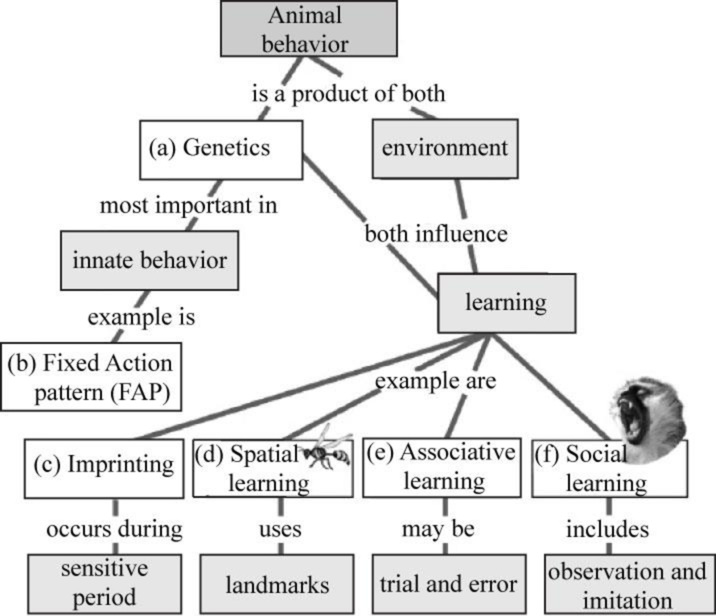
Concept explainers
To complete: The given map that reviews the genetic and environmental components of animal behavior and their relationship to learning.
Introduction:
The action of behavior is carried by the muscles that are in control of the nervous system in response to environmental stimulus. Thus, the behavior of animal is the response from internal and external environmental stimulus.
Explanation of Solution
Pictorial representation:
Fig.1 shows the completed map that reviews the genetic and environmental components of animal behavior and their relationship to learning.

Fig.1: Components animal behavior and their relationship to learning.
(a)
Correct answer: Genetics.
The animal behavior is a combined effect of genetics and environment and both influence the learning in animals. However, genetics is the main cause of innate behaviors. Hence, the correct answer is genetics.
(b)
Correct answer: Fixed Action pattern (FAP).
FAP is an unchangeable series of action caused by a particular stimulus. Hence, the correct answer is FAP.
(c)
Correct answer: Imprinting.
Imprinting is the sensitive phase that occurs after the hatching of the young ones. The first person that the young ones see will imprint with them like the hatched newborns see their mother; so, they follow her in a straight line whenever she goes for a walk. Hence, the correct answer is imprinting.
(d)
Correct answer: Spatial learning.
Spatial learning is the memories of landmarks created by animals with in their environment. The landmarks include trees, water, and mountains to find their way to home. It helps them to find a mate, food, nest, and possible dangers. The landmarks include trees, water, and mountains to find their way to home. Hence, the correct answer is spatial learning
(e)
Correct answer: Associative learning.
Associative learning is the association of result with a particular action by animals like while training a dog an individual feeds them with treats on performing well in training so they associate the food with the behavior while they learn. Hence, the correct answer is associative learning.
(f)
Correct answer: Social learning.
Social learning is the learning from other’s behavior by just watching or observing them. In an experiment, many octopus were put through the maze, while one is going in the maze, the others were tend to watch and the next time when they perform, they remember the path and finish it within less time. This concludes that the animals watch and learn from other’s behavior for a particular situation. Hence, the correct answer is social learning.
Want to see more full solutions like this?
Chapter 35 Solutions
CAMP.BIO:CONC...MOD.MAST+PRINT>I<
- 22. Which of the following mutant proteins is expected to have a dominant negative effect when over- expressed in normal cells? a. mutant PI3-kinase that lacks the SH2 domain but retains the kinase function b. mutant Grb2 protein that cannot bind to RTK c. mutant RTK that lacks the extracellular domain d. mutant PDK that has the PH domain but lost the kinase function e. all of the abovearrow_forwardWhat is the label ?arrow_forwardCan you described the image? Can you explain the question as well their answer and how to get to an answer to an problem like this?arrow_forward
- Describe the principle of homeostasis.arrow_forwardExplain how the hormones of the glands listed below travel around the body to target organs and tissues : Pituitary gland Hypothalamus Thyroid Parathyroid Adrenal Pineal Pancreas(islets of langerhans) Gonads (testes and ovaries) Placentaarrow_forwardWhat are the functions of the hormones produced in the glands listed below: Pituitary gland Hypothalamus Thyroid Parathyroid Adrenal Pineal Pancreas(islets of langerhans) Gonads (testes and ovaries) Placentaarrow_forward
 Biology (MindTap Course List)BiologyISBN:9781337392938Author:Eldra Solomon, Charles Martin, Diana W. Martin, Linda R. BergPublisher:Cengage Learning
Biology (MindTap Course List)BiologyISBN:9781337392938Author:Eldra Solomon, Charles Martin, Diana W. Martin, Linda R. BergPublisher:Cengage Learning Biology: The Dynamic Science (MindTap Course List)BiologyISBN:9781305389892Author:Peter J. Russell, Paul E. Hertz, Beverly McMillanPublisher:Cengage Learning
Biology: The Dynamic Science (MindTap Course List)BiologyISBN:9781305389892Author:Peter J. Russell, Paul E. Hertz, Beverly McMillanPublisher:Cengage Learning Comprehensive Medical Assisting: Administrative a...NursingISBN:9781305964792Author:Wilburta Q. Lindh, Carol D. Tamparo, Barbara M. Dahl, Julie Morris, Cindy CorreaPublisher:Cengage Learning
Comprehensive Medical Assisting: Administrative a...NursingISBN:9781305964792Author:Wilburta Q. Lindh, Carol D. Tamparo, Barbara M. Dahl, Julie Morris, Cindy CorreaPublisher:Cengage Learning Human Heredity: Principles and Issues (MindTap Co...BiologyISBN:9781305251052Author:Michael CummingsPublisher:Cengage Learning
Human Heredity: Principles and Issues (MindTap Co...BiologyISBN:9781305251052Author:Michael CummingsPublisher:Cengage Learning Human Physiology: From Cells to Systems (MindTap ...BiologyISBN:9781285866932Author:Lauralee SherwoodPublisher:Cengage Learning
Human Physiology: From Cells to Systems (MindTap ...BiologyISBN:9781285866932Author:Lauralee SherwoodPublisher:Cengage Learning





